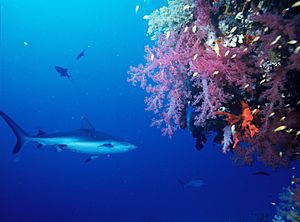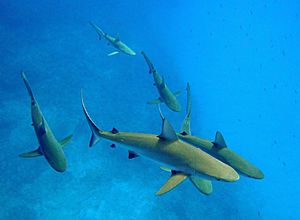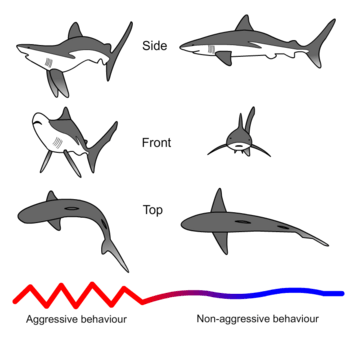Grey reef shark facts for kids
Quick facts for kids Grey reef shark |
|
|---|---|
 |
|
| Conservation status | |
| Scientific classification | |
| Genus: |
Carcharhinus
|
| Species: |
amblyrhynchos
|
 |
|
| Range of the grey reef shark | |
| Synonyms | |
|
Carcharias amblyrhynchos Bleeker, 1856 |
|
The grey reef shark (Carcharhinus amblyrhynchos) is a type of requiem shark. It belongs to the family called Carcharhinidae. This shark is one of the most common sharks found on coral reefs in the Indo-Pacific region. You can find it from South Africa all the way to Easter Island.
Grey reef sharks usually live in shallow waters near the edges of coral reefs. They have a typical "reef shark" look. This includes a wide, round snout and big eyes. You can tell them apart from similar sharks by their plain or white-tipped first dorsal fin. Other fins have dark tips, and their tail fin has a wide, black edge. Most grey reef sharks are less than 1.9 meters (6.2 feet) long.
These sharks are fast and agile predators. They mostly eat bony fish and cephalopods like squid. Even though they are not huge, they are quite aggressive. This helps them be in charge over other shark species on the reef. Many grey reef sharks stay in a specific area of the reef. They are social animals, not territorial. During the day, they often gather in groups of 5 to 20 sharks. They usually do this near reef drop-offs. At night, they split up to hunt for food. Female sharks also form groups in very shallow water. The warmer water there might help them or their unborn young grow faster.
Like other sharks in its family, the grey reef shark is viviparous. This means the mother gives birth to live young. She feeds her embryos through a special connection called a placenta. They usually have one to six pups every two years. The grey reef shark was the first shark known to do a shark threat display. This is a special behavior that warns others it's ready to attack. The shark will hunch its back, drop its pectoral fins, and swim with an exaggerated side-to-side motion. They often do this if divers follow or corner them. This shows they feel threatened. Grey reef sharks have been involved in some attacks on humans. It's important to be careful around them, especially if they start this display.
This species is caught by many fisheries. Its population can decrease quickly because it doesn't have many babies. Also, it doesn't spread out much. Because of this, the International Union for the Conservation of Nature (IUCN) says this species is endangered.
Contents
What is a Grey Reef Shark?
The grey reef shark was first described in 1856 by a Dutch scientist named Pieter Bleeker. He gave it the scientific name Carcharias (Prionodon) amblyrhynchos. Later, scientists moved it to the group of sharks called Carcharhinus. This shark is also known by other names around the world. These include grey shark, graceful shark, and shortnose blacktail shark. Some of these names are also used for other shark species.
Scientists believe the grey reef shark is closely related to the silvertip shark (C. albimarginatus). They figured this out by looking at their body shapes and tooth types.
Appearance and Features
The grey reef shark has a smooth, strong body. It has a long, blunt snout and big, round eyes. Both its upper and lower jaws have 13 or 14 teeth on each side. The upper teeth are triangle-shaped with slanted points. The bottom teeth are narrower and stand up straight. The first dorsal fin is medium-sized. There is no ridge between its first and second dorsal fins. Its pectoral fins are narrow and curved like a sickle.
The shark's back is grey, sometimes with a bronze shine. Its belly is white. The back edge of its caudal fin (tail fin) has a clear, wide black band. The tips of its pectoral, pelvic (bottom pair), second dorsal, and anal fins are dark or black. Sharks from the western Indian Ocean might have a thin white tip on their first dorsal fin. This is usually not seen in sharks from the Pacific Ocean. Grey reef sharks that spend time in shallow water can get darker. This is like getting a "sun tan." Most grey reef sharks are less than 1.9 meters (6.2 feet) long. The longest one ever reported was 2.6 meters (8.5 feet) long. The heaviest was 33.7 kilograms (74.3 pounds).
Where They Live
The grey reef shark lives in the Indian Ocean and Pacific Oceans. In the Indian Ocean, you can find them from South Africa to India. This includes places like Madagascar, the Red Sea, and the Maldives. In the Pacific Ocean, they live from southern China to northern Australia and New Zealand. They are also found around many Pacific islands. Some of these islands include Hawaii, Guam, and Samoa.
These sharks usually live near the coast in shallow water. They are often found in water less than 60 meters (200 feet) deep. But they have been seen diving as deep as 1,000 meters (3,300 feet). They like coral reefs with clear water and rocky areas. They are often found near the steep drop-offs at the outer edges of reefs. They are less common inside lagoons. Sometimes, these sharks swim several kilometers out into the open ocean.
Life on the Reef
The grey reef shark is one of the most common sharks on Indo-Pacific reefs. Other common ones are the blacktip reef shark and the whitetip reef shark. Grey reef sharks often push other shark species out of their favorite spots. This happens even with sharks that are bigger than them. Where grey reef sharks and blacktip reef sharks live together, the blacktips stay in shallow areas. The grey reef sharks prefer deeper water.
Sometimes, grey reef sharks swim in the open ocean. There, they might swim with marine mammals or large pelagic fishes. For example, about 25 grey reef sharks were once seen following a group of bottlenose dolphins. Rainbow runners (a type of fish) have been seen rubbing against grey reef sharks. They do this to scrape off parasites using the shark's rough skin.
Larger sharks, like the silvertip shark, sometimes hunt grey reef sharks. At Rangiroa Atoll, great hammerheads eat grey reef sharks. This happens when the grey reef sharks are tired from chasing mates.
What Grey Reef Sharks Eat
Grey reef sharks mainly eat bony fish. Cephalopods like squid and octopus are their second most important food. They also eat crabs and lobsters. Bigger sharks tend to eat more cephalopods. These sharks hunt alone or in groups. They have been seen trapping schools of fish against the reef walls to catch them. Groups of up to 700 grey reef sharks have been seen hunting together. They are very good at catching fish swimming in the open water. This is different from whitetip reef sharks, which are better at catching fish inside caves.
Their sense of smell is amazing. They can smell a tiny bit of tuna in a huge amount of seawater. If there is a lot of food, grey reef sharks can get into a feeding frenzy. This is when many sharks become very excited and aggressive while eating. In one case, an underwater explosion killed some fish. The sharks started a frenzy, and one grey reef shark was attacked and eaten by the others.
Reproduction and Life Cycle
When grey reef sharks mate, the male bites the female's body or fins. This helps him hold onto her during mating. Like other requiem sharks, they are viviparous. This means the mother gives birth to live young. The baby sharks grow inside the mother. At first, they get food from a yolk sac. Later, the yolk sac turns into a placenta. This connection feeds them until they are born.
Each female has one working ovary and two working uteri. They usually have one to four pups every two years. In Hawaii, they can have up to six pups. The number of babies increases with the size of the mother. The gestation period (how long the babies are inside the mother) can be from 9 to 14 months. Pups are usually born from July to August in the Southern Hemisphere. In the Northern Hemisphere, they are born from March to July. Newborn sharks are about 45 to 60 centimeters (18 to 24 inches) long.
Grey reef sharks become adults around seven years old. Males are about 1.3 to 1.5 meters (4.3 to 4.9 feet) long then. Females are about 1.2 to 1.4 meters (3.9 to 4.6 feet) long. Sharks on the Great Barrier Reef become adults later, at 11 years old. They also tend to be a bit larger. These sharks can live for at least 25 years.
Shark Behavior
Grey reef sharks are active day and night. They are most active when it gets dark. In some places, groups of about 30 sharks spend the day together. At night, they spread out into shallower water to find food. Their home range is about 0.8 square kilometers (0.3 square miles). In other areas, sharks might swim long distances along the reef. Or they might stay in specific areas during the day and night. Where there are strong tidal currents, grey reef sharks move with the water flow. This might help them smell their prey better. It could also give them cloudy water to hide in while hunting.
Grey reef sharks are not very territorial. They let other sharks of their kind enter their home areas and feed. Some sharks stay in the same part of the reef for up to three years. Others move around regularly.
Social Life of Grey Reef Sharks
Grey reef sharks often gather in groups. In the Hawaiian Islands, many pregnant females have been seen swimming slowly in circles in shallow water. These groups usually last from late morning to mid-afternoon. Females also form groups in shallow water at other locations. These groups can change in size each year. The sharks start arriving in the morning and reach their largest numbers in the afternoon. They then spread out by evening. Individual sharks return to these gathering spots every few days.
Scientists think these female sharks use the warmer shallow water. This might help them or their unborn babies grow faster. The shallow water might also help them avoid male sharks. In some parts of the reef, grey reef sharks are more solitary. But near reef drop-offs, groups of 5 to 20 sharks form in the morning. These groups grow larger during the day and then spread out at night. In flat areas, sharks form schools of about 30 individuals near the sea bottom. They swim in the same direction or slowly in circles. Most sharks in these schools are females. Scientists think these schools might be related to mating or giving birth.
The Threat Display
The "hunch" shark threat display of the grey reef shark is the most famous warning display of any shark. This behavior has been studied when sharks react to divers. Sometimes, these displays have led to attacks. When a shark performs this display, it raises its snout and drops its pectoral fins. It arches its back and curves its body from side to side. While in this position, the shark swims with a stiff, exaggerated side-to-side motion. It might also roll or swim in figure-eight patterns.
The display becomes more intense if a diver gets closer. It also gets stronger if the shark's escape routes are blocked. If the diver keeps coming closer, the shark might swim away. Or it might quickly attack with its mouth open, slashing with its upper teeth. Most of these displays happen when a diver follows the shark from behind and above. They also do this display towards moray eels. In one case, a grey reef shark even displayed towards a much larger great hammerhead, which then swam away.
However, grey reef sharks have never been seen doing this display towards each other. This suggests the display is mainly a warning to potential threats, like predators. Since grey reef sharks are not territorial, they are thought to be defending their own "personal space." Sharks from the Indian Ocean and western Pacific are generally less aggressive. They are also less likely to perform this display compared to sharks from other areas.
Interactions with Humans
Grey reef sharks are often curious about divers at first. They might swim quite close. But they usually lose interest if divers return many times. They can become dangerous if there is food around. They also tend to be more aggressive in open water than on the reef. There have been several known attacks on spearfishers. These attacks might have happened by mistake, when the shark aimed for a speared fish near the diver.
This species will also attack if it feels chased or trapped. Divers should slowly swim away if a shark starts its threat display. Always face the shark as you leave. Do not try to photograph the display. The flash from a camera has caused at least one attack. Even though they are not huge, they can cause a lot of damage. In one study, a grey reef shark attacked a research submarine many times. It left tooth marks in the plastic windows and bit off a propeller. The shark launched its attacks from 6 meters (20 feet) away. It could cover that distance in just a third of a second. As of 2008, the International Shark Attack File listed seven unprovoked attacks and six provoked attacks by this species. None of these attacks were deadly.
Even though they are still common in untouched areas, grey reef shark populations can decrease quickly. This is because they have a slow reproduction rate. They also need specific habitats and tend to stay in one area. The International Union for the Conservation of Nature (IUCN) has listed the grey reef shark as endangered. These sharks are caught by many fisheries for products like shark fin soup and fishmeal. Another problem is the ongoing damage to coral reefs from human activities.
There is proof that some populations have dropped a lot. For example, in the Chagos Archipelago, grey reef shark numbers in 1996 were only 14% of what they were in the 1970s. In the Great Barrier Reef, grey reef shark populations in fishing zones had dropped by 97% compared to areas where fishing was not allowed. Even areas where fishing was prohibited had similar low numbers. This shows how serious poaching (illegal hunting) can be. Without more conservation efforts, it was predicted that the shark population could fall to just 0.1% of its original size within 20 years. One way to help save them is through ecotourism. Grey reef sharks are good for shark-watching tours. Many countries, like the Maldives, now protect profitable diving sites.
See also
In Spanish: Tiburón gris para niños









